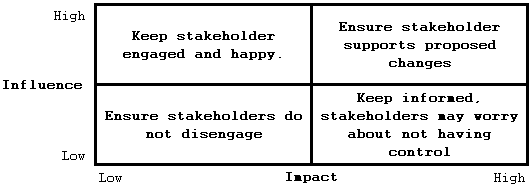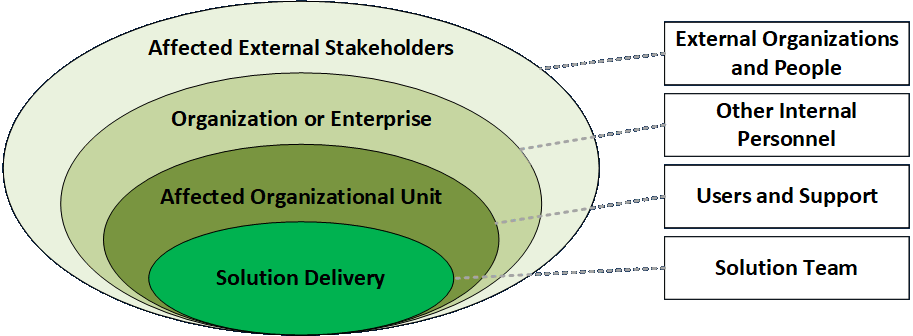Many different tools can be used to describe different kinds of stakeholders. In general, a stakeholder is anyone involved in or affected by any organizational activity, across the entire potential life cycle of that activity. This encompasses the design and implementation of an organizational process, along with its execution and maintenance.
A stakeholder list is no more or less than an enumeration of the different participants, usually in terms of their roles. Important distinctions of classes of stakeholders are internal vs. external, creator vs. user vs. manager vs. maintainer, type of implementation specialist (programmer, graphic artist, database specialist, content and story analyst, etc.), provider vs. customer vs. experiencer of externalities, and so on. (Which other divisions can you think of?)
Stakeholder maps come in two forms, a stakeholder matrix and an onion diagram. A matrix essentially contrasts two continuous scales, the level of influence of the stakeholder and the impact on the stakeholder (i.e., how the stakeholder affects others vs. how they are affected by others).

Stakeholder onion diagrams show which participants have the most affect on or are most affected by different systems or solutions. While the roles may vary in their specifics, they don’t really change in character. It’s also true that customers, who are presumably represented in the outer ring and thus least affected (or drive the process the least) can be internal personnel and may also be the primary beneficiaries of the new or modified system, whether directly or indirectly.

Stakeholders may further be classified using a RACI matrix (or a responsibility matrix), which describes whether people in different roles are (or should be):
- Responsible: These individuals are charged with performing the requisite analysis, implementation, testing, and deployment required to effect the desired system or modification.
- Accountable: This individual (of whom “There can be only one!“) is held accountable for accomplishing what is desired.
- Consulted: These individuals provide input into the work to be performed, but neither perform it nor are accountable for it.
- Informed: These individuals are notified about what is happening and what has happened, but otherwise how no input or responsibility for the work. They may, however, be the ultimate users or beneficiaries.
Finally, stakeholders of different kinds, most typically users, may be defined in terms of personas. Many different kinds of people may interact with systems and processes in different capacities, and their duties, privileges, and interactions need to be defined in appropriate detail. All envisioned personas must be identified during the analysis so their needs may be properly addressed in the new or modified system or process. All of the tools of business analysis can be applied to ensure this analysis is thorough and accurate.
